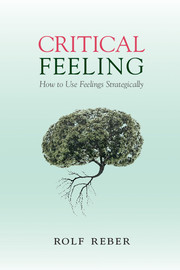Book contents
- Frontmatter
- Dedication
- Contents
- Preface
- Part I The basics of critical feeling
- Part II Applications of critical feeling
- 4 Happiness through critical feeling
- 5 The role of sensory and bodily feedback
- 6 Living together
- 7 Critical feeling in business and politics
- 8 Critical feelings at school
- 9 Music, art, and literature
- 10 Religion and morality
- Epilogue
- Notes
- References
- Index
6 - Living together
from Part II - Applications of critical feeling
Published online by Cambridge University Press: 05 March 2016
- Frontmatter
- Dedication
- Contents
- Preface
- Part I The basics of critical feeling
- Part II Applications of critical feeling
- 4 Happiness through critical feeling
- 5 The role of sensory and bodily feedback
- 6 Living together
- 7 Critical feeling in business and politics
- 8 Critical feelings at school
- 9 Music, art, and literature
- 10 Religion and morality
- Epilogue
- Notes
- References
- Index
Summary
Let me not to the marriage of true minds
Admit impediments. Love is not love
Which alters when it alteration finds,
Or bends with the remover to remove:
Oh no! It is an ever-fixèd mark
That looks on tempests and is never shaken;
It is the star to every wand'ring bark,
Whose worth's unknown, although his height be taken.
Love's not Time's fool, though rosy lips and cheeks
Within his bending sickle's compass come;
Love alters not with his brief hours and weeks,
But bears it out even to the edge of doom.
If this be error and upon me proved,
I never writ, nor no man ever loved.
(William Shakespeare 2003/1609, Sonnet 116)The previous chapter reviewed evidence that coordinated action increases social rapport. Even infants imitate the facial expression of their mothers (Meltzoff and Moore 1977). Mothers and infants synchronize their behavior (Trevarthen 1979) and coordinate their facial movements with each other's (Stern 1977, 1985). Children and adults may act in synchrony with others in order to increase social cohesion. The social functions of emotion are so pervasive (see Campos, Mumme, Kermoian, and Campos 1994) that Saarni (1999) claimed that emotions cannot be understood but in connection to social interaction. We learn emotions through social interaction, we employ them in social interaction, and we understand the emotions of others through social interaction. Moreover, using emotions strategically can be done not only for the sake of individual well-being and skill acquisition but also for the sake of collective concerns (see Wikan 1990 for an example from anthropology).
How much can we extend to feelings in general the idea that emotions are interwoven within their social context? Social interaction can determine feelings beyond emotions in several ways. First, from early childhood on, our preferences are shaped through instrumental conditioning. At the beginning parents, later peers, tell children what to like and what to dislike (see Bourdieu 1984/1979 for a sociological analysis). Although we may retain some autonomy in determining our tastes, preferences are embedded in our social ecology. Second, other people expose us to objects and experiences. As repeated exposure influences feelings in a positive direction – at least as long as we are not overexposed – parents have an opportunity to guide tastes by showing their son what they want him to like, …
- Type
- Chapter
- Information
- Critical FeelingHow to Use Feelings Strategically, pp. 145 - 162Publisher: Cambridge University PressPrint publication year: 2016

